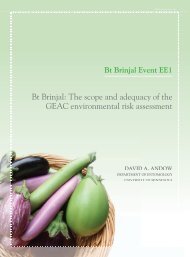Whose Biomass?A tale of two bioeconomiesEvangelists of the new bioeconomy like to frame it as a returnto a previous, sustainable economy, in which humancivilization relied on the natural bounty of the present ratherthan robbing from the mineral deposits of the past. But whilethe global economy as a whole might have taken a centurylongdetour from that bio-based economy, billions of peopledid not. They – that is, peasants, indigenous peoples,pastoralists, fisherfolk, forest dwellers and other traditionalcommunities – remained independent of the hydrocarboneconomy; however, as climate change accelerates, they arepaying its costs…• Two centuries after the industrial revolution began burningcoal, three billion people, two-thirds of whom live in theglobal South, still depend upon firewood as their primarysource of fuel for heat and cooking. 66• One hundred thirty years after Edison enabled electricitydistribution, 1.6 billion people have no access to electricitywhether sourced from coal, wind, water or woodchips. 67• One hundred forty years after Siegfried Marcus firstattached a combustion engine to a vehicle, 2 billion peoplestill rely on animals as their main source of power foragriculture and transport; indeed, half of the farmland in theglobal South is tilled exclusively by animals. 68These biodiversity-based economies dependon exactly the same natural resources(plants, land, water, animal products)that the new bioeconomy intends tocapture for conversion into industrialchemicals and energy. Moreover, theso-called ‘biomass’ that industryintends to grab is not only alreadyused as a resource by thesecommunities, but it is alsointerdependently connected with theircultures and knowledge systems.The Land Grab: current rush to buy land in the globalSouth. The past few years have witnessed a massiveupswing in the number of deals buying and leasingagricultural land in the tropics by Northern investors andstates. The term was coined by civil society organizationGRAIN.An existingbioeconomy alreadydepends on biomassfor fuel, power andmaterials.Photo: Adam Jones“Land bestsuited for biomassgeneration (Latin America,Sub-Saharan Africa) is the leastutilized.”– Presentation by Steven Chu (nowU.S. Secretary of State for Energy)at the Asia Pacific PartnershipConference, Berkeley, USA,19 April 2006Marginal Lands forMaximal ProfitBiomass advocates refer to “marginal,”“unproductive,” “idle,” “degraded” and“abandoned” lands and “wastelands” asthe target for biomass extraction,claiming that as many as 500 millionhectares of abandoned or marginal landare available worldwide for growingbiomass crops. 69 Such claims appear to bebased on satellite data showing areas offormer cropland. However, a closer look atthese “marginal lands” from ground level revealsthat they are often where marginalized people subsist. Farfrom being ‘abandoned’ or ‘degraded,’ their uses are merelyinvisible to a system that recognizes only private ownershipand industrial agriculture (and carries out its assessments fromouter space).The New Biomassters 15
Illustration: the Beehive CollectiveTable: A tale of two bioeconomiesBiomass-based economiesHomogenous - Defines plantand other organic life by lowestcommon denominators: asundifferentiated providers of‘feedstocks’ – sugars, starch,cellulose, oil, etc.Monoculture - Organizeslarge-scale sourcing ofmonoculture crops, plantations,forest destruction and landclearance.Market driven - Based onindustrial transformation ofbiomass into bulk commoditiesfor the global market – e.g.,electricity, biofuels, bulkchemicals, pharmaceuticals, textiles.High tech - Uses, proprietary,capital-intensive technologies totransform biomass – e.g., biotech,synthetic biology, syntheticchemistry. Innovation occursquickly and diffuses rapidly on alarge scale – often prematurely.Reductionist – Nature is viewedin terms of its commercial valueand profit potential.Biodiversity-based economiesHeterogenous - Definesplant life and organic lifeheterogeneously by differentiatingindividual species and parts ofplants and animals with specificproperties and uses.Diverse - Organizes small-scalecultivation of diverse cropping andgathering of wild harvests. When itoccurs, land clearance is onrotational or shifting basis.Subsistence driven - Based oncommunity or individualtransformation of plant and animalmaterials for personal or communityuse – e.g., as medicines, food,cultural and spiritual uses.Appropriate tech - Uses humanscale, community-centredtechnologies to transform plants –e.g., drying, fermenting, cooking.Innovation may occur quickly but onsmall scales and diffuses slowly tolarger scales.Holistic - Nature is imbued withcultural and spiritual values andoften seen as sacred.As a coalition of CSOs reports in aninvestigation of the marginal lands myth:“Communities that use these biodiversity-richlands for food, income, grazing and medicinedo not appreciate the denial of their existence.Nor do they always agree that the conversionof their lands for agrofuel production willbring ‘development’ benefits.” 70 A study byGören Berndes, who has reviewed 17bioenergy feasibility studies, found that, “Landreported to be degraded is often the base ofsubsistence for the rural population.” 71For example, grasslands are described as “idle”even when they provide subsistence to pastoralpeoples and nomads who require extensivegrazing coverage to maintain a light impact ondelicate ecosystems. Jonathan Davies, globalcoordinator of the World Initiative forSustainable Pastoralism, based in Nairobi,Kenya, comments, “These marginal lands donot exist on the scale people think. In Africa,most of the lands in question are activelymanaged by pastoralists, hunter-gatherers andsometimes dry land farmers.” 72 Davies goes on:“Given the current cavalier approach to landappropriation, or the disregard of the landrights of rural inhabitants in many countries, itis inevitable that agrofuel production will bedone by large investors at the expense of localcommunities.”Disturbingly, far from being an innocentoversight, the denial of small farmer andpastoralist rights and the grabbing of theirlands appear to be part of the plan. Forexample, a 2004 report by leading Europeanresearchers noted that the bulk of biofuelpotential comes from pasture land and assertedthat, “A prerequisite for the bioenergypotential in all regions is …that the presentinefficient and low-intensive agriculturalmanagement systems are replaced in 2050 bythe best practice agricultural managementsystems and technologies.” 73 In other words,“remove the peasantry.”Indeed, what is clear from this emphasis ontargeting the lands of marginalized peoples isthat the so-called new bioeconomy can onlytake root by displacing pre-existingbioeconomies.ETC Group 16 www.etcgroup.org











